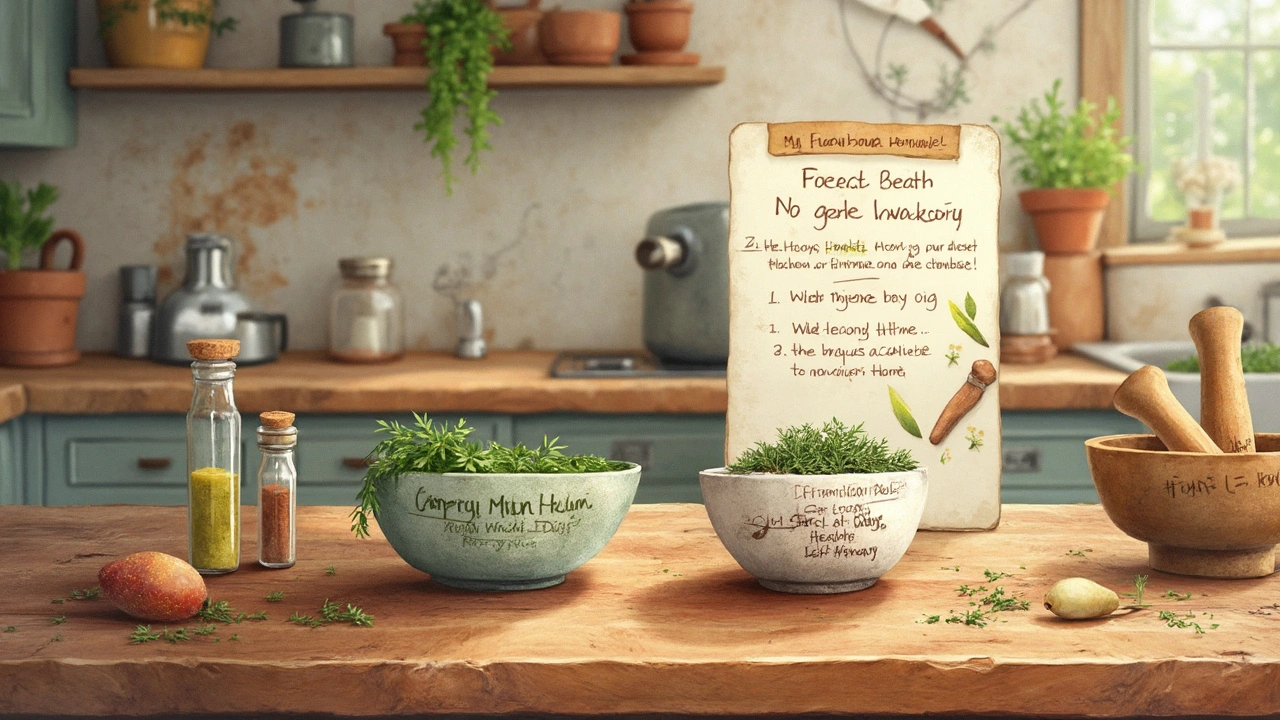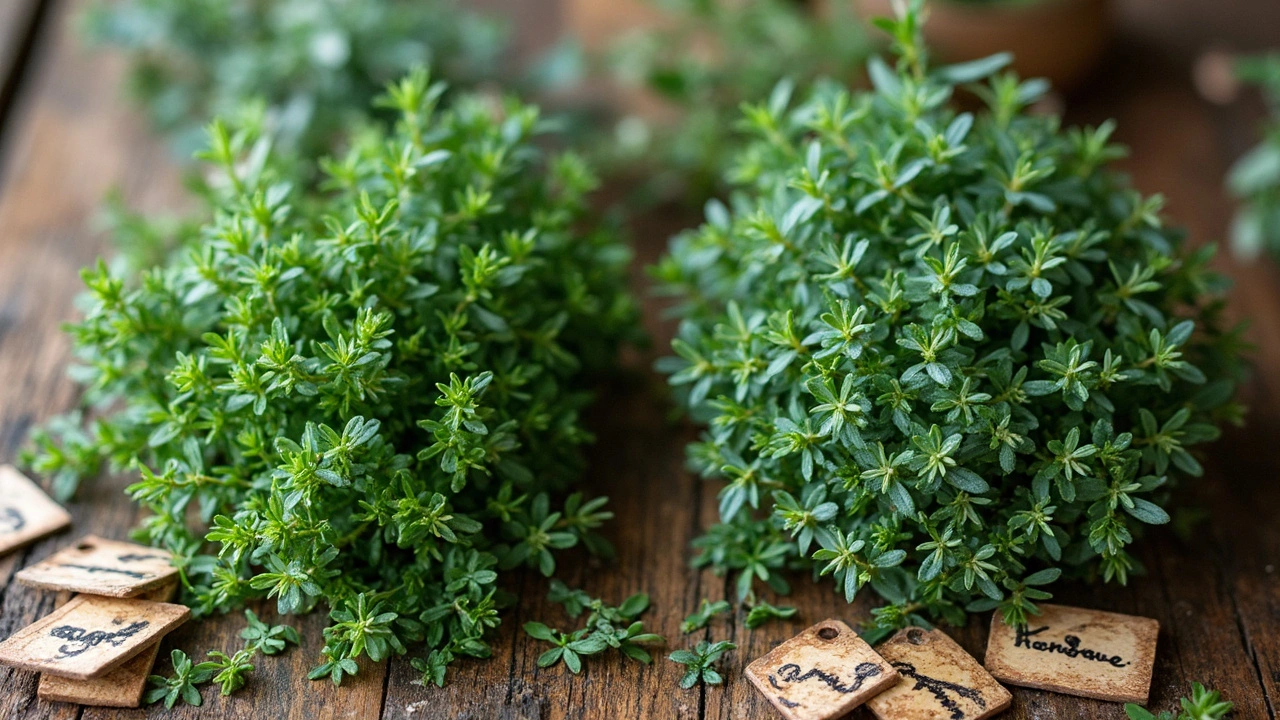The Botanical Breakdown: What Sets Wild Thyme Apart from Common Thyme?
You’d think thyme is thyme, right? Not even close. Wild thyme, also known as Thymus serpyllum, and common thyme, or Thymus vulgaris, look pretty similar at a distance but go totally different ways under the microscope. Wild thyme usually creeps along rocky hills, putting out tiny purple blooms, while common thyme grows upright in backyard pots all around Sydney. People often overlook wild thyme, thinking it’s just a weed, but botanists say it’s more adapted to rough, poor soils and wild weather—the sort of resilience you taste in every bite.
The leaves of wild thyme are smaller, rounder, and fuzzier. They can handle harsh winters, while common thyme wants a bit more tender love and care. You get a stronger, slightly more “herbal” taste with wild thyme—think grassy with a dash of mint. In contrast, common thyme feels sweeter, softer, and more floral. That wild side shows up in the intensity of their essential oils, which we’ll dig into soon. People in Mediterranean villages, where wild thyme runs rampant, throw branches into cooking fires for a powerful aroma no supermarket bottle can match. It’s not just tradition—it’s chemistry.
When it comes to growing, common thyme wins for kitchen gardens. It likes consistent sun and just enough water. Wild thyme? It’s a survivor and will take on hot paving stones, dry slopes, or forgotten corners. There’s something poetic about wild thyme fighting to stay alive—its oils become more concentrated, and in harsh years, locals swear those plants carry a stronger punch, almost like nature’s superfood. No wonder old herbalists prized wild thyme for situations where only the toughest plants would do.
Essential Oil Profiles: The Heavy Hitters Behind the Scent
This is where things get spicy: the essential oils hidden in both wild and common thyme are surprisingly different—and much more complicated than most people realize. The magic comes down to chemotypes, which are basically ‘chemical personalities’ shaped by where and how the plants grow. Common thyme is famous for its high thymol content. Thymol is a powerhouse compound that gives thyme its antispetic, earthy punch—that stuff in your grandma’s chest rub or cough drops owes plenty to thyme.
But get this: not every common thyme plant packs the same chemical wallop. Some might be rich in thymol, others in carvacrol or linalool. It depends on the soil, weather, region, and even when you pick the leaves. There are seven or more recognized chemotypes—each with a slightly different effect. For example, the thymol type fights bacteria like a champ, while the linalool type is way more gentle and often ends up in skincare products for sensitive skin.
Wild thyme doesn’t just follow suit. Its essential oil blend often comes in stronger on the carvacrol side, which some studies (like a 2022 analysis in the Journal of Applied Botany) claim blitzes fungi and even antibiotic-resistant bugs more effectively than standard thymol-rich oils. That’s wild, literally. There’s also borneol and geraniol—compounds that clinicians in herbal medicine sometimes use for calming nerves or opening up breathing passages.
If you want numbers: wild thyme oil can clock in with up to 40% carvacrol, while common thyme can hit about 50% thymol in certain chemotypes. But it’s the combos and ratios that count—Mother Nature doesn’t always stick to formulas. When making your own infusions or looking for serious therapeutic results, paying attention to the chemotype listed on the label matters. No, you don’t need a chemistry set to tell the difference, but herbal shops in Australia worth their salt will label their bottles, so you’re not guessing.

Medicinal Potency: Wild Thyme Versus Common Thyme
Now let’s get to what everyone really wants to know: which works better, and for what? Both wild and common thyme have earned spots in traditional medicine cabinets for centuries, but which one should you actually grab for wellness?
Common thyme is famous for fighting colds, soothing coughs, and knocking down sore throats. You’ll find it in tons of herbal lozenges, teas, and syrups. The main reason is that thymol’s antibacterial and antiviral effects have been proven over and over—including in recent clinical studies, where thyme extracts helped people recover faster from respiratory bugs. Chefs use it more because its flavor suits almost everything, but the medicinal kick is no accident—it’s in the oils.
Wild thyme, on the other hand, has a reputation as a “heavy lifter” in folk medicine. Herbalists used to send it home with people dealing with chronic bronchitis, asthma, or persistent skin infections—largely because the wild version appears more robust in its antimicrobial range. Carvacrol, its star compound, not only trounces bacteria like staph but can even slow down some nasty fungi, as shown in research from Scandinavian health journals tracking folk remedies. Some even brew it for sleep or tension headaches, claiming its balanced blend of natural oils tackles anxiety when nothing else works.
But here’s the twist: wild thyme’s stronger raw taste can put people off in teas—but in essential oils and supplements, that’s an advantage. If you’re trying to fend off bugs (or just clean your shower grout naturally), wild thyme comes out on top for sheer punch. That said, people with sensitive stomachs or skin sometimes prefer common thyme’s milder effect. Wild thyme is less likely to turn up in supermarkets but pops up in specialty supplement lines or wild-crafted blends advertised for high-powered immune support.
Wild Thyme or Common Thyme: Choosing the Right Type (and Chemotype) for You
So which one is the champion? It all comes down to what you’re after. Want to add serious flavor depth to roast lamb or homemade stock? Grab common thyme—preferably fresh. Chasing hardy oils for fighting off winter bugs or boosting a homemade remedy kit? Wild thyme, especially the carvacrol-rich kind, is your go-to. Not all thyme oil bottles are labeled with chemotype, but if you spot ‘CT Thymol’ or ‘CT Carvacrol’, you’re looking at essential information that serious herbalists value. Don’t overlook this if you’re after specific effects.
Many experienced cooks in Sydney sneak in a pinch of wild thyme with the common stuff when marinating meats or prepping veggies. It gives you depth and a more complex aroma. For supplements, a blend of both (labeled with major chemotypes) can bring the best of both worlds if you’re dealing with seasonal bugs or want to experiment. Want to geek out even more? Ask your local herbalist about soil and climate—the same thyme plant in wet coastal Sydney can turn out different oils than a cousin growing up in dusty outback dirt.
Safety first—wild thyme’s essential oil is way too strong to use undiluted. Even a drop in a steaming bowl or a DIY cleaner goes a long way. Apply oils to skin with a carrier (like olive or almond) and patch test first; chemotypes high in carvacrol or thymol can irritate super-sensitive skin. For internal use, always talk to a pro. And if you’re curious about wild thyme vs common thyme benefits, a quick read online can help you see which one matches your goals, with case studies spelled out in real detail.

Kitchen Hacks, Storage Tips, and Fun Facts About Thyme
Foodies in Australia get creative with thyme, throwing both wild and common versions into everything from infused honey to kombucha. Want a wild thyme oil that won’t overpower salads? Pick leaves fresh in the morning, when the aromatic oils are peaking, and let them soak in cold-pressed olive oil for a week. The result: a knockout, minty-herbal flavor that makes ordinary toast feel like bush-tucker royalty.
Storage counts, too. Both types of thyme hold their essential oils better if dried in the shade—sun can wreck the delicate oils. Store in airtight jars out of light. A sprinkle of dried, crumbled wild thyme on woodfired pizza brings out a unique smoky finish you can’t fake. For quick relief from a stuffy head, just inhaling steam from steeped common thyme has helped me more than any shop-bought decongestant. Give it a try next rainy night and see for yourself.
For the ecologically minded: wild thyme attracts more pollinators like bees and butterflies because its blooms are bigger and brighter. Growing some in your patch helps the whole garden flourish. And here’s a secret: combine wild thyme with rosemary and lemon zest, breathe it in, and you’ll see why it’s been the backbone of old-school Mediterranean remedies for centuries.
If you want more data, some suppliers list oil content by percentage, like this:
| Thyme Type | Main Oil | Peak Oil Content (%) |
|---|---|---|
| Wild Thyme | Carvacrol | Up to 40 |
| Common Thyme (Thymol CT) | Thymol | Up to 50 |
| Common Thyme (Linalool CT) | Linalool | 12-15 |
So, next time you spot those scraggly thyme bushes clinging to sunblasted rocks, don’t walk past them. That’s where science and old wisdom overlap—chemotypes, oils, and health benefits, all locked up in a couple of humble green sprigs. Whether you’re a home chef or an experiment-happy herbalist, understanding the real difference between wild thyme and common thyme changes the game.






Mina Berens
July 18, 2025 at 11:31
Wow, I never realized there were such nuanced differences between wild thyme and common thyme! 🌿
The deep dive into essential oils really makes me want to experiment with both in my kitchen and even for natural remedies. I loved the practical tips part – super useful for someone like me who's always trying to pick the "right" herb for different dishes and health hacks.
Have you noticed a big flavor difference in cooking? Or is it more about the health benefits when choosing one over the other?